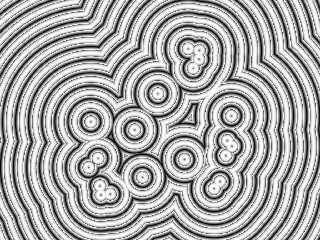|
 |
This is very similar in concept to the Voronoi pattern, and indeed, if the
"annular rings" are fine enough, one gets the visual impression of Voronoi cells
filled with a concentric ring pattern.
I just did this for fun, to illustrate a practical pattern to use for ripples in
water, malachite, rhodochrosite, wood, "jawbreaker" candies, etc, and to
implement an example that makes use of splines, loops, pseudorandom numbers, and
a discrete set of "basis functions" that are evaluated "en-masse".
Enjoy the "bubbles".
(Speaking of which, this could be a fun one to apply iridescence to...)
I'd have to think about how to vary the "radius" of each seed point, and then
apply the true bubble intersection formula to get a nice foam cross-section.
Foam isosurface, anyone?
- BE
Post a reply to this message
Attachments:
Download 'mathpatterns1.png' (704 KB)
Preview of image 'mathpatterns1.png'

|
 |
|
 |
"Bald Eagle" <cre### [at] netscape net> wrote:
> Over the last 2 days, I've fallen down the mathematical pattern rabbit hole, and
> have been experimenting with all manner of what can be done with a simple
> pigment {function {}}
> statement.
>
Two older ones for your collection. Thing I found on the web years ago:
---%<------%<---
// Persistence of Vision Ray Tracer Scene Description File
// File: contour.pov
// Vers: 3.5
// Desc: contour plots Idea: Eric Weeks
// http://www.physics.emory.edu/~weeks/ideas/tplot.html
// Date: 2003
// Auth: Ingo Janssen
#version 3.5;
#include "gradients.inc"
//https://news.povray.org/povray.binaries.scene-files/message/%3CXnsA9D7C1F3776F3seed7%40news.povray.org%3E/#%3CXnsA9D7
C1F3776F3seed7%40news.povray.org%3E
global_settings {assumed_gamma 1.0}
camera {location <0,0,-25> look_at 0}
#declare Contour = function(x,y,z,A,B,C,D,E,F,I,J,K,L) {
E*sin(A*sin(I*x)+ B*cos(J*y))+F*cos(C*cos(K*x)+D*sin(L*y))
}
#declare A =1;
#declare B =1;
#declare C =1;
#declare D =1;
#declare E =1;
#declare F =1;
#declare I =1;
#declare J =1;
#declare K =1;
#declare L =1;
#declare Test = function(Pf){
(G_smoothstep(Pf,0.1,0.15)-G_smoothstep(Pf,0.15,0.2))
+(G_smoothstep(Pf,0.4,0.6)-G_smoothstep(Pf,0.7,.9))
};
plane {
-z, 0
pigment {
function{Contour(x,y,z,A,B,C,D,E,F,I,J,K,L)}
//function{G_Blinn_Wyvill(Contour(x,y,z,A,B,C,D,E,F,I,J,K,L))}
//function{Test(Contour(x,y,z,A,B,C,D,E,F,I,J,K,L))}
//function{abs(Contour(x,y,z,A,B,C,D,E,F,I,J,K,L))}
//sine_wave
colour_map {
[0 rgb 0]
[1 rgb 1]
}
}
finish {ambient 1}
}
---%<------%<---
---%<------%<---
// POV-Ray 3.7
// Ingo
// found on a Japanese site
// +w1280 +h480 +a0.05 +am3 +ac0.90 +r3
#version 3.7;
global_settings{assumed_gamma 1}
#default{ finish{ambient 0 diffuse 1}}
camera {
orthographic
location <0,0,1>
look_at 0
right x*image_width/image_height
}
#declare PHI = 1.61803399;
// Shuhei Kawachi
// A>0
#declare ShuheiKawachi = function (x,y,z,A,B){
((cos(x)*cos(y)+cos((sqrt(A)*x-y)/B)*
cos((x+sqrt(A)*y)/B)+cos((sqrt(A)*x+y)/B)*
cos((x-sqrt(A)*y)/B)))/3///6 + 0.5
}
plane{ <0,0,-1>, 0
texture {
pigment {
//function{(ShuheiKawachi(x,y,z,pi,1.5))}
function{abs(ShuheiKawachi(x,y,z,pi,1.5))}
sine_wave
scale 0.02
}
finish {ambient 1 diffuse 0}
}
}
---%<------%<---
ingo net> wrote:
> Over the last 2 days, I've fallen down the mathematical pattern rabbit hole, and
> have been experimenting with all manner of what can be done with a simple
> pigment {function {}}
> statement.
>
Two older ones for your collection. Thing I found on the web years ago:
---%<------%<---
// Persistence of Vision Ray Tracer Scene Description File
// File: contour.pov
// Vers: 3.5
// Desc: contour plots Idea: Eric Weeks
// http://www.physics.emory.edu/~weeks/ideas/tplot.html
// Date: 2003
// Auth: Ingo Janssen
#version 3.5;
#include "gradients.inc"
//https://news.povray.org/povray.binaries.scene-files/message/%3CXnsA9D7C1F3776F3seed7%40news.povray.org%3E/#%3CXnsA9D7
C1F3776F3seed7%40news.povray.org%3E
global_settings {assumed_gamma 1.0}
camera {location <0,0,-25> look_at 0}
#declare Contour = function(x,y,z,A,B,C,D,E,F,I,J,K,L) {
E*sin(A*sin(I*x)+ B*cos(J*y))+F*cos(C*cos(K*x)+D*sin(L*y))
}
#declare A =1;
#declare B =1;
#declare C =1;
#declare D =1;
#declare E =1;
#declare F =1;
#declare I =1;
#declare J =1;
#declare K =1;
#declare L =1;
#declare Test = function(Pf){
(G_smoothstep(Pf,0.1,0.15)-G_smoothstep(Pf,0.15,0.2))
+(G_smoothstep(Pf,0.4,0.6)-G_smoothstep(Pf,0.7,.9))
};
plane {
-z, 0
pigment {
function{Contour(x,y,z,A,B,C,D,E,F,I,J,K,L)}
//function{G_Blinn_Wyvill(Contour(x,y,z,A,B,C,D,E,F,I,J,K,L))}
//function{Test(Contour(x,y,z,A,B,C,D,E,F,I,J,K,L))}
//function{abs(Contour(x,y,z,A,B,C,D,E,F,I,J,K,L))}
//sine_wave
colour_map {
[0 rgb 0]
[1 rgb 1]
}
}
finish {ambient 1}
}
---%<------%<---
---%<------%<---
// POV-Ray 3.7
// Ingo
// found on a Japanese site
// +w1280 +h480 +a0.05 +am3 +ac0.90 +r3
#version 3.7;
global_settings{assumed_gamma 1}
#default{ finish{ambient 0 diffuse 1}}
camera {
orthographic
location <0,0,1>
look_at 0
right x*image_width/image_height
}
#declare PHI = 1.61803399;
// Shuhei Kawachi
// A>0
#declare ShuheiKawachi = function (x,y,z,A,B){
((cos(x)*cos(y)+cos((sqrt(A)*x-y)/B)*
cos((x+sqrt(A)*y)/B)+cos((sqrt(A)*x+y)/B)*
cos((x-sqrt(A)*y)/B)))/3///6 + 0.5
}
plane{ <0,0,-1>, 0
texture {
pigment {
//function{(ShuheiKawachi(x,y,z,pi,1.5))}
function{abs(ShuheiKawachi(x,y,z,pi,1.5))}
sine_wave
scale 0.02
}
finish {ambient 1 diffuse 0}
}
}
---%<------%<---
ingo
Post a reply to this message
|
 |




![]()